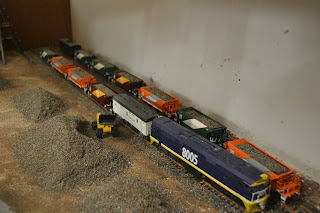This week I
was really crook and spent a couple of days at home and did not get anywhere
near the shed. However, Saturday at about midday was another story.
I ventured down and started work on the southern end of Clapham Yard.
Firstly I soldered power jumpers to each of the tracks at the south end of the
yard. I also wired up the two relocated points motors. I then reviewed
the programming on the NCE Mini-panel that controlled the southern end of the
yard and identified where I had to change the programming as I removed some
points from various routes. Basically 5 of the 7 routes are now working
from the old control panel. I drilled two more holes in the control panel
and moved one push button and added another one. However, these two new routes
will have to be controlled from another mini panel – the northern end
one, as there are no longer any free buttons in the existing southern
mini-panel.
My very expensive control panels. I have not rubbed out the old lines, nor filled the hole left by the moved push button.
While testing the power connections out on the southern end of the yard, it became obvious that I had made my dual gauge track very tight. So I slightly widening it bit by bit with the help of my soldering iron. Levering the third rail out slightly. After this was done, I had no issues running my 1550 up and down all the tracks.
So after
completing this work, I decided to re-attach the layout lighting to the section
above the northern end of Clapham Yard. I first added a small extension
onto the southern end of the lighting pelmet above The Risk. I then added
two new ‘L’ brackets to attach the pelmet supports to the wall. I then
cut a new pelmet to joining the section from Clapham Yard to The Risk
section.
After lunch on
Sunday (after doing some garden work for the boss) I added the metal reflector to the pelmet and then reglued in the LED
strip. I then ran the power cord back to the power supply and then gave the
lights a test run. Perfect!
It looks now like we have a continuous lighten from the southern end of Clapham Yard all the way around to The Risk.
I then decided to wire up the two changed push button on the southern Clapham Yard Panel back to the mini-panel at the northern end. I just had enough wire. They have been tested and work well. I have also hand drawn where the new push buttons will go on the northern panel. I also identified what point was what number and tonight I will write out the changes for the mini-panel so I code it up this week.
The mini-panel in question with the new connection in locations 17 and 18 on the left and northern control panel with the new button locations drawn on the panel. Again the old connection shave not been rubbed out yet. I will have to lay a new wire back to mini-panel for the new button.
I then set about wiring up the two moved point motors at the northern end of Clapham Yard. At this point in time, the motor on the left works like a charm, and the one of the right has a huge bind somewhere in the throw chain and nothing moves even though the motor is trying to move it. Well that will be next weeks job.
The two new point motors located away from the points and using wire under the track to activate the points.
So the last shot shows the current view of Clapham Yard populated with a few locos and wagons and everything works up to this position in the yard. More jumpers need to be added to the northern end next week.
The now half usable Clapham Yard.


























